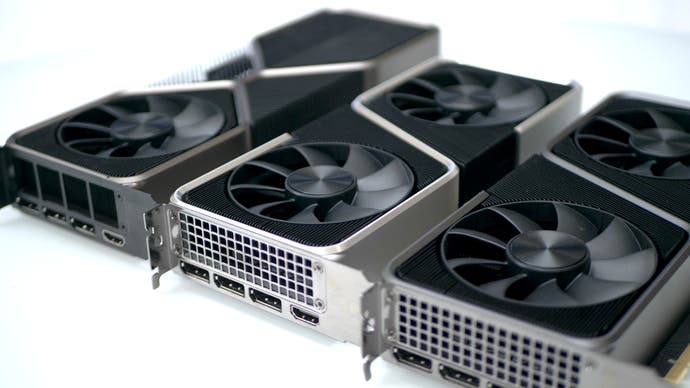Nvidia RTX 3060 Ti review: the Digital Foundry verdict
Competitive at its price-point - and a huge upgrade for the money vs 10-Series Pascal cards.
Across the bulk of our testing, the RTX 3060 Ti has shown itself to be a solid value, often delivering nearly 90 per cent of the performance of the RTX 3070 while costing closer to 85 per cent of the price. In most games, the 3060 Ti manages to hold a clear advantage over the RTX 2080 Super, a card that costs £320 more and came out just last summer, underlining the impressive boost Nvidia has been able to find this generation.
In more modern games, especially those that use RT effects, the 3060 Ti is even better still. It's a particular blow against AMD, with the 3060 Ti out-muscling the significantly more expensive RX 6800 XT in most of the RT game scenes we tested. The 3060 Ti is also among the most power-efficient cards we've found so far, although the 3070 and RX 6800 were able to deliver a superior 'joules per frame' measurement in one of the two games we used for judging this. Clearly, the Ampere architecture is as competitive in the mid-range as it is at the very top.
But perhaps the best argument to be made for the RTX 3060 Ti comes in its performance differentials against the 10-series Pascal cards, where you're often getting 80 to 90 per cent more performance than the venerable GTX 1070, with even GTX 1080 Ti often humbled by the output of the new card. While RTX 3060 Ti will work best at 1440p resolution, the fact is that 1080 Ti still runs a wide range of games well at 4K resolution - where 3060 Ti will do considerably better, even before we factor in the inclusion of DLSS. We're really looking forward to testing this with Cyberpunk 2077.

Beyond performance, the industrial design here deserves plaudits too. The 3060 Ti feels like a very expensive graphics card in the hand, with a surprising amount of heft for its dimensions, and it looks great too - that shining metal tracing a path around the fans definitely does it for me. That also translates into great thermal performance; the 3060 Ti was routinely amongst the coolest cards I've tested recently and I never heard the fans spin up aggressively enough to become noticeable against the two 140mm fans on the AiO CPU cooler, even during sustained testing sessions. With HDMI 2.1 and AV1 decode on board, the 3060 Ti also brings important media standards to a new low price point - although, as ever, I mourn the loss of that useful extra USB-C port on the previous-gen models.
One nagging concern remains availability. The RTX 3070, 3080 and 3090 have all appeared momentarily in their launch window and then promptly disappeared for weeks, and we're now facing the very real prospect that no RTX 30-series cards will be available in decent numbers until sometime next year. AMD has faced similar issues and the state of the world remains a mitigating factor, but for these reviews to be anything but academic both teams will have to be able to get their cards in shops at RRP, rather than hundreds of pounds above it. Whoever is able to do so first could attain a decisive advantage going into 2021, the first full year of next-gen gaming, so I hope for the sake of competition that we see better availability on both sides.
With the 3060 Ti's performance now out in the open, it's time for AMD to put forward its champion. The RX 6800 and 6800 XT have proven to be worthy adversaries, RT performance and machine learning features aside, and it'll be fascinating to see how a more mid-range Big Navi part - Medium Navi? - fares against the baseline Nvidia has laid out today.
Nvidia GeForce RTX 3060 Ti Analysis
- Introduction, Hardware and Power Analysis
- Doom Eternal, Control, Borderlands 3, Shadow of the Tomb Raider - Game Benchmarks Part 1
- Death Stranding, Far Cry 5, Hitman 2, Assassin's Creed Odyssey - Game Benchmarks Part 2
- Metro Exodus, Dirt Rally 2, Assassin's Creed Unity - Game Benchmarks Part 3
- Control, Metro Exodus, Battlefield 5 - RTX Game Benchmarks
- Nvidia GeForce RTX 3060 Ti - the Digital Foundry verdict [This Page]
